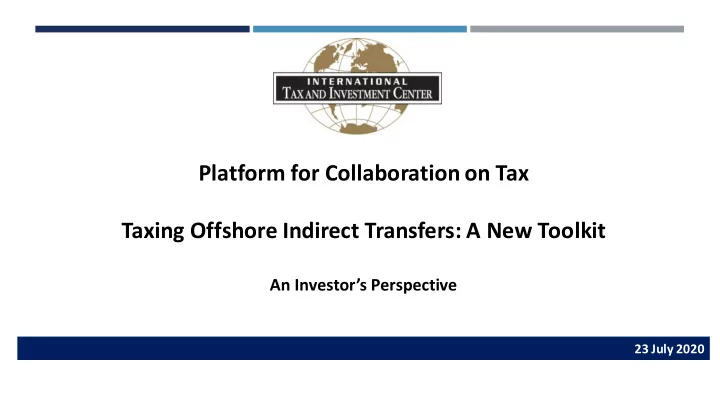

Platform for Collaboration on Tax Taxing Offshore Indirect Transfers: A New Toolkit An Investor’s Perspective 23 July 2020
COMMENT SUMMARY: AN INVESTOR’S PERSPECTIVE I. Toolkit is not a recommendation and leaves decision for each country (Toolkit p. 9) Countries should have greater information on the option not to tax ➢ Norway and the United States don’t (Toolkit p. 20, footnote 27) II. Reasons not to tax OITs involve interplay of investor/country perspectives Reducing investor risks can increase country income Ability to add/change investors can increase country income Taxing OITs may reduce value to a country Adding administrative complexity and diverting resources increase country costs/risks III. IF tax OITs, need to avoid double taxation/retroactivity Need to step up basis of in-country assets Losses need to be deductible (including carrybacks/carryforwards) Law changes should be prospective only
RISK “It’s all about risk and reward……Offering a stable, consistent and predictable tax environment, with a fair, transparent and timely appeals process is very valuable to IOCs. If you can convince them that you will provide this they will accept a higher government take.” [Quoted in UN Handbook on Taxation of the Extractive Industries] Countries competing for capital affirmatively use risk reduction to maximize value Corollary is where risks are increased, investors will require a greater return ➢ Barriers to entry of new partners increase risks/reduce “optimization” prospects “Predictable tax environment” certainly means no retroactive tax changes ➢ If investor can’t rely on law in place, risk increases— lowering government take
COMPARE COUNTRY REVENUES WITH NO SALE CASE Country/Investor agree on exploration and development terms ➢ Reflects expectations of each, both in amount and timing of revenues Investors calculate returns on discounted cash flow basis at project rates (not external borrowing or cost of capital rates — See IMF FARI model) The net income from the property/project is what is available for sharing — no more and no less (Toolkit Box 1 explanation, p. 14) ➢ Agreement terms should promote, not discourage, activities that increase overall project value What happens if there is a partial or total change of investors? ➢ If not taxable, original terms simply remain in place — no acceleration or deceleration ➢ If taxable, it accelerates — or decelerates if at a loss — the expected cash flows to country
PRACTICAL IMPLICATIONS ▪ Country’s revenues are same over the project irrespective of OIT tax decision (Toolkit pp. 15 and 16) ▪ Receiving $1000 today versus 10 years later, creates a $450 time value benefit at a 6% country borrowing rate (Toolkit p. 15). ▪ But what about the investor? An investor “paying” $1000 today, and recovering it 10 years later, suffers a time value “loss” of $700-800 using its risk-weighted discount rate of 12-15%. ➢ Certainly doesn’t encourage bringing in new partners— increasing risks ▪ BUT this illustrates the potential win- win “sweet spot” of different discount rate perspectives ➢ A country can increase absolute and present value of revenues by deferring a timing difference ▪ Clearly should be considered in structuring agreed fiscal terms, including whether to tax OITs
CONCLUSIONS C onsiderable “momentum” to tax OITs -- BUT it actually is a choice! The choice to tax has economic impacts that should be understood COUNTRY SHOULD FULLY EVALUATE THE PROS AND CONS BEFORE MAKING OIT DECISIONS If after full analysis, a country does decide to tax OITs: ➢ I t needs to “step up” the basis in the in -country operating assets ➢ It should treat losses the same as gains — with tax carryback/forward mechanism ➢ The scope of taxation on an OIT should be no greater than on a domestic transaction ➢ The law should be clear on all of these points — neither taxpayer nor tax administrator should have to guess ➢ If a change in law is desired, it should prospective only
Platform for Collaboration on Tax Taxing Offshore Indirect Transfers: A New Toolkit An Investor’s Perspective 23 July 2020
Recommend
More recommend